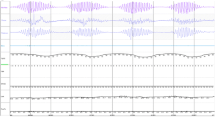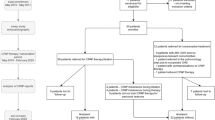Abstract
Introduction
Obstructive sleep apnoea (OSA) as well as central sleep apnoea (CSA) are highly prevalent in heart failure (HF) patients. Positive airway pressure (PAP) therapy is usually intended to treat OSA and CSA. The aim of the present study was to investigate immediate hemodynamic effects of PAP therapy in these patients.
Materials and methods
In 61 consecutive HF patients (NYHA ≥ II, EF ≤ 45%) with moderate to severe OSA or CSA (AHI ≥ 15/h) blood pressure (BP) and heart rate (HR) response to PAP therapy initiation was investigated during mask fitting with patients being awake and in supine position. While applying an endexspiratory pressure of 5.8 ± 0.9 cm H2O, there was a significant decrease in systolic (−8.9 ± 12.1 mmHg, p < 0.001) and diastolic BP (−5.1 ± 9.2 mmHg, p < 0.001) without a change in HR (p = n.s.).
Results
At least a transient drop in mean arterial pressure ≤70 mmHg was seen in 10% of these patients. Logistic regression analysis revealed a significant impact of baseline BP on potential BP drops: lower baseline BP was associated with BP drops.
Conclusion
PAP therapy may cause unexpected hypotension especially in patients with low baseline BP as seen in HF patients treated according to current guidelines. Whether these hypotensive effects sustain, cause any harm to the patients and/or is responsible for non-acceptance or non-adherence of PAP therapy needs to be determined.


Similar content being viewed by others
References
Oldenburg O, Lamp B, Faber L, Teschler H, Horstkotte D, Töpfer V (2007) Sleep disordered breathing in patients with symptomatic heart failure. Eur J Heart Fail 9:251–257
Vazir A, Hastings P, Dayer M, McIntyre HF, Henein MY, Poole-Wilson PA, Cowie MR, Morrell MJ, Simonds AK (2007) A high prevalence of sleep disordered breathing in men with mild symptomatic chronic heart failure due to left ventricular systolic dysfunction. Eur J Heart Fail 9:243–250
Bradley T, Floras J (2003) Sleep apnea and heart failure. Part I: obstructive sleep apnea. Circulation 107:1671–1678
Bradley T, Floras J (2003) Sleep apnea and heart failure: part II: central sleep apnea. Circulation 107:1822–1826
Somers V, White D, Amin R, Abraham WT, Costa F, Culebras A, Daniels S, Floras JS, Hunt CE, Olson LJ, Pickering TG, Russell R, Woo M, Young T (2008) Sleep apnea and cardiovascular disease: an American Heart Association/American College of Cardiology Foundation scientific statement from the American Heart Association Council for High Blood Pressure Research Professional Education Committee, Council on Clinical Cardiology, Stroke Council, and Council on Cardiovascular Nursing. J Am Coll Cardiol 52:686–717
Dickstein K, Cohen-Solal A, Filippatos G, McMurray JJ, Ponikowski P, Poole-Wilson PA, Strömberg A, van Veldhuisen DJ, Atar D, Hoes AW, Keren A, Mebazaa A, Nieminen M, Priori SG, Swedberg K, ESC Committee for Practice Guidelines, Vahanian A, Camm J, De Caterina R, Dean V, Dickstein K, Filippatos G, Funck-Brentano C, Hellemans I, Kristensen SD, McGregor K, Sechtem U, Silber S, Tendera M, Widimsky P, Zamorano JL (2008) ESC guidelines for the diagnosis and treatment of acute and chronic heart failure 2008. Eur Heart J 29:2388–2442
Becker H, Grote L, Ploch T, Schneider H, Stammnitz A, Peter JH, Podszus T (1995) Intrathoracic pressure changes and cardiovascular effects induced by nCPAP and nBiPAP in sleep apnoea patients. J Sleep Res 4(Suppl 1):125–129
Montner P, Greene E, Murata G, Stark D, Timms M, Chick T (1994) Hemodynamic effects of nasal and face mask continuous positive airway pressure. Am J Respir Crit Care Med 149:1614–1618
Acosta B, DiBenedetto R, Rahimi A, Acosta MF, Cuadra O, Van Nguyen A, Morrow L (2000) Hemodynamic effects of noninvasive bilevel positive airway pressure on patients with chronic congestive heart failure with systolic dysfunction. Chest 118:1004–1009
Philip-Joët F, Paganelli F, Dutau H, Saadjian A (1999) Hemodynamic effects of bilevel nasal positive airway pressure ventilation in patients with heart failure. Respiration 66:136–143
De Hoyos A, Liu P, Denard D, Bradley T (1995) Haemodynamic effects of continuous positive airway pressure in humans with normal and impaired left ventricular function. Clin Sci 88:173–178
Steiner S, Schannwell C, Strauer B (2008) Left ventricular response to continuous positive airway pressure: role of left ventricular geometry. Respiration 76:393–397
Naughton M, Rahman A, Hara K, Floras J, Bradley T (1995) Effect of continuous positive airway pressure on intrathoracic and left ventricular transmural pressures in patients with congestive heart failure. Circulation 91:1725–1731
Liston R, Deegan P, McCreery C, Costello R, Maurer B, McNicholas W (1995) Haemodynamic effects of nasal continuous positive airway pressure in severe congestive heart failure. Eur Respir J 8:430–435
Johnson C, Beanlands R, Yoshinaga K, Haddad H, Leech J, de Kemp R, Burwash IG (2008) Acute and chronic effects of continuous positive airway pressure therapy on left ventricular systolic and diastolic function in patients with obstructive sleep apnea and congestive heart failure. Can J Cardiol 24:697–704
Author information
Authors and Affiliations
Corresponding author
Rights and permissions
About this article
Cite this article
Oldenburg, O., Bartsch, S., Bitter, T. et al. Hypotensive effects of positive airway pressure ventilation in heart failure patients with sleep-disordered breathing. Sleep Breath 16, 753–757 (2012). https://doi.org/10.1007/s11325-011-0571-4
Received:
Revised:
Accepted:
Published:
Issue Date:
DOI: https://doi.org/10.1007/s11325-011-0571-4




